#it could be information - myths. places. people of interest. facts
Explore tagged Tumblr posts
Text

saw these again, they're kinda neat i think
#perceptive little crow#fettered paintbrushes#back when i was trying to figure out how a myth teo would work in the current context#still feel she'd be from a response to trauma. but i feel it'd lean on the idea of “to hide and be hidden”#to hide in order protect oneself and others#it could be information - myths. places. people of interest. facts#it could be her#i guess she'd wonder how it'd feel had she had some sort of anonymousy(?) on her life#but im kinda rambling about an idea which i haven't give that much thought#either way. i feel The Incident would be a good catalizer(?) and then years of working on the company would take her toll#until The Incident 2(¡) happens and she just snaps#honestly i have this problem of wanting to add too much bullshit on a character and then having no clue how to link it together#which sucks but it's whateverrrrr
3 notes
·
View notes
Note
Time for some thoughts on the heavenly aspects of heavenly crow demons!
I've gathered from readings various xianxia works that demon kind (Mó Zú, 魔族) and 'heart demons' (Xīn Mó, 心魔) are both called Mó (魔) because the two are intertwined. Demons are either 1) beings that succumbed to their own heart demons, 2) physical manifestations of the heart demons of individuals or people generally, 3) cosmic entities that foster heart demons in other people, or 4) decedents of other demons formed via the former methods. In other words, you don't get a demon without some sort of heart demon being associated with them!
In SVSSS, Heavenly Demons are very explicitly of the first category! They were heavenly beings, but "fell to depravity" and became demons, with the Zuiyin (罪印, Mark of Sin) being a physical manifestation of their fall from the heavens.
When Binghe's seal was broken, he was overcome with bloodlust and the "desire to inflict savage cruelty," which along with all their blood related powers, seems to indicate the major heart demon his Heavenly Demon bloodline suffers from is specifically bloodlust. I'd hazard a guess that a tendency towards anger, and perhaps the need for vengeance, may be manifestations of that heart demon too (succumbing to anger certainly makes Binghe's mark glow brighter and spread).
Thinking about the ex-Jinwu Heavenly Demon Crows, their particular heart demon should be related to vanity, pride, and carelessness. Depending on how you interpret the myth, they almost burned the world to ashes just to mess around, and perhaps be admired, so it seems fitting!
Based on this, Heavenly Demon Crows have a strong tendency towards luxury, pampering, and playing around. If they're trapped somewhere stuffy and boring, are forced to perform menial labors, or are in a sorry state where they don't get to show off their fine garments (or plumage) and sparkly jewelry to be admired, they tend to get quite irritated about it.
Speaking of jewelry, since Heavenly Demon Crows used to be pure gold, their current mostly 'drab' black appearance with only gold feather tips and a slightly gold sheen, is quite tragic to them. It contributes to their grand desire to cover themselves in glitter and gold to make up it!
Luckily for Shen Yuan, he unknowingly snags himself a man who will be thrilled to spoil him rotten, take him to interesting places, and cover him in all the gold and fine silks he could ever want!
First of all, the level of thought you've put into demons is admirable and I will never be able to think of anything else when I'm thinking about demons. Woarh...so many kinds of demons - all so fascinating...So, heavenly demons as once heavenly beings, which is just wild to think about - and the Zuiyin information!! I'm not afraid to admit that I'm very hopeless when it comes to things into this, so this is all information that I am chewing on quite gently THE VANITY, PRIDE AND CARELESSNESS SIN LINKING TO THE CROW DEMONS YES YES YES!!! The idea of Shen Yuan slowly falling for these typicalities within his bloodline, it's so so silly, the idea that he just randomly walks into his little nest home and realises that he's SURROUNDED by gold and glitter and shiny shit, and he's just like "....ohhhh. OHHHHHH-" I love the idea of a huffy Shen Yuan doing something to help out the locals (he loves helping the local villages, even if he hates doing work), and a couple of crows watching as he lugs along a cart of dirt and quietly bemoans the fact that anything shiny he has is thoroughly caked with dirt - he may be helpful, but he likes to be shiny :(( BINGHE GIVING HIM LITERALLY EVERYTHING HE COULD EVER WANT - He so much as LOOKS at something? It's immediately his. Immediately. I love this. I wish I could say more but this speaks for itself. (Check the crowyuan au tag on my Tumblr for more!! I'll probably answer a couple more asks about it tomorrow because I'm only on half a day of learning and I've got a few more interesting asks to blab about!! :D)
#four being a dumbass#crowyuan au#of the heavenly demon variety#this one will be turned around in my brain for a long time#this is perfection alone#my commentary isn't even needed lmao#scum villian self saving system#ren zha fanpai zijiu xitong#scum villain#mxtx svsss#svsss au#svsss#shen yuan#luo binghe#bingqiu
97 notes
·
View notes
Text
youtube
Farya Faraji did it again! This is a great episode presenting most Greek music instruments, while providing a lot of context, information, jokes, history lessons and as always he debunks all the myths and stereotypes about Greek music. In this video he is interviewing Demetrios Dallas, a Greek American polymusician (if that's a term in English) who can literally play ALL.
Chapters:
Intro
Bagpipes and reeds
Flutes and clarinet
Bowed instruments
Lutes
Kanonaki and Santouri
Percussions
Context of Greek music
Regional diversity
Rhythmic patterns
It's always changing
Pitch in the modal traditions
Westernisation and revival
The last chapter is thematically the most important and Farya is at the moment the most well known person / youtuber who calls out this massive misconception about Greek music. You see there is this whole, extremely rigid notion in Western Europe that Greek music was western but it was orientalized because Greeks were conquered by the Turks and were turkified and lost their identity. It was exactly the opposite in fact. Greek music was what you 'd call "eastern" (yes, including ancient Greek music, yes, including Homer times, Pericles times, blah blah blah) and it actually started westernising itself ONLY by the mid to late 19th century, meaning after the independence from the Ottomans and the establishment of the modern Greek state and the reason was the severe trauma of this whole ordeal. After its independence Greece SO did not want to have anything to do with Turkey and the East in general that for the first time it oriented itself totally towards the west in most everything. Farya is a bit bitter about it (you know, being of Iranian descent and interested in folk music and all) but because he's great and very knowledgeable at what he does, there is also all this analysis about how (especially after the population exchange with Turkey in which Anatolian Greeks moved to Greece) the eastern element re-established itself in the country. It remained marginalised for a long time but as it happens with things that are essentially your identity, it resurfaced and almost claimed its natural place. However, the biggest talents and minds of Greek music in the 20th century were largely trained in western music tradition and the music legacy they left behind is so monumental that the Greek music will almost certainly never become again as eastern as it once was. And that's okay because what was produced by these people was so essentially and uniquely Greek that it is now part of the Greek heritage, an eastern foundation glossed in western styles and the product is our trademark modern music.
*I loved when mr Dallas says how he has noticed that this aversion for heritage is being changed by the young generation and how just 20 years ago he could not find anyone in Greece to make him an askomandura and now he picks up the phone and there are at least 20 instrument makers who can do the job. It's amazing and it's not that far from what I was saying some time ago that I see it's the young people who slowly slowly try to make a change.
76 notes
·
View notes
Note
Child of Venus (or alternatively a legacy) Tim Drake.
First really quickly going to run down some very basic history quickly.
Roman Venus comes from the Greek Aphrodite, who comes from the Western Semitic goddess Astarte, who is known by the ancient Mesopotamian as Ishtar and earlier Ianna.
This is an extreme overview of thousands of years of history, but it conveys my point. I want to explore all of these aspects quickly before I get into my thoughts on how this connects. (Also, like an extreme basic rundown of things that people might not know)
Ianna - is the goddess of love and war (along with several other fields) but is also heavily associated with divine law and political power. An interesting fact is that she was actually a three-form goddess. She went from a fairly localised deity to one of the most venerated deities across Mesopomeia. When the Assyrians took over, she became the highest deity, even above their national ones. She was so popular and essential that she is alluded to in Hebrew text. She didn’t experience a proper decline until the period between the 1st century CE and the sixth century CE when Christianity became widespread. She was in more myths than any other Sumerian deity. https://en.wikipedia.org/wiki/Inanna
Astarte - is the goddess of these associated combinations: war, royal power, healing, and hunting (and several others). The travels, trade, and colonisation of the people would end with her being worshipped and an accepted deity in many places, from Egypt to the Iberian peninsula. She is considered to be the equivalent of Isis in some schools of thought. Her worship would land in Cyprus, where she could have merged with a local goddess and would slowly go to mainland Greece during the late Mycenean era or the following post-Broze age collapse. In the Greek classical period, she was occasionally equated with Aphrodite through (what a great many Polythetsic cultures did) the practice of synchronising deities. https://en.wikipedia.org/wiki/Astarte
Aphrodite - is the goddess of love, beauty, and passion (along with the others everyone knows). She is one of the twelve Olympians and is one of the most widely celebrated and worshipped deities in the Hellenic world. Some of her other epithets were Eleemon (the merciful) and Enoplios (armed). She was called Tymborychos (gravedigger) along with the previously discussed Areia (the warlike) in one of her darker, more violent natures. https://en.wikipedia.org/wiki/Aphrodite# https://en.wikipedia.org/wiki/Aphrodite_Areia
Venus - is the goddess of desire, prosperity, and victory. She is the ancestor of the Roman people through her son, and Julius Ceaser claimed to have been her ancestor. A couple of the epithets I want to highlight for a moment are Fleix (lucky), Genetrix (the mother), Physica Pompeiana (Pompeii’s protective goddess), Verticordia (charger of hearts), and Victrix (victorious) https://en.wikipedia.org/wiki/Venus_(mythology)
Okay, now let's move on to my thoughts because this consumed my brain so much that I needed to grab my computer and write it down.
The Thoughts!
I’ll start with the child of Venus and then do the legacy version.
Janet and Venus. Imagine if, on one of the important archaeology trips, Janet comes across something important to Venus. It could be anything, whether it be the start of new ruins of a worship spot or a statue. Venus appreciates Janet's respect towards the findings and wants to know more about Janet. (There is also the fact that there is an extreme difference between the number of men and women in archaeology, especially field archaeology.) The two of them share a conversation where Janet shows interest in the history of Venus, and Venus herself drops the idea that the history behind Venus and the goddesses that precede her is also enjoyable. It was a test. Janet takes this information, wanting to have another conversation with the woman and learns as much as possible. Realising that she can do more field research, she sets it up. Venus appreciates this, and he wonders whether Tim is just the kid of Janet and Venus or if he has a three-parent setup. Tim exists.
Did Venus more or less give Janet a quest? Yes. Does Janet regret it? No. It is a very cute and tragic set-up because to be favoured by the gods is to be doomed by them. You could change up their death a bit, too. To match the tragedy vibe.
Tim grows up learning all about his parent's work. It may not have been his favourite, but he listened and learned. Tim, sent to boarding schools and in the comics, always saw school as a necessity but something secondary—Tim, who was often separate from his parents. What if when Dick Grayson’s parents died (Monster attack?), his parents realised just how dangerous the world is, and they sent him to different boarding schools to try and keep him safe. It could also explain some of Jack’s attitude. Knowing that Tim isn’t truely his. Knowing the reality that fate could hand his son. Explain why he often sits back to parenting, knowing that his son could die in tragedy young, but also why he clings sometimes. Why will he hammer down on parenting when he realises that he can’t protect his kid and his kid could die?
Now onto Tim. Tim loves his city so much. Tim goes back to Gotham even when his whole family moves. Tim would do anything for Gotham. That is Passion and Love. That is dedication. Tim, who becomes Robin. Who must go through a much longer trail and training before becoming Robin properly? He who trained under Shiva, who Shiva sees potential for. He who chooses an unconventional weapon. One that does not quickly kill but requires skill and ability to use. (He is fighting a war in Gotham but also loves Gotham. He hurts and helps. He causes pain, and he saves. He brings himself to ruin to help his loved ones in his beloved city and make something better for the world he lives in.)
Tim finds himself victorious most of the time but sometimes has to rely a bit on luck. He is Robin, a protector of Gotham. Tim, by the way of being Robin, is trying to create a better Gotham. Tim is the one who created the Batfamily as we know it. He often gets people to work together that do not work together very well.
He is also well-travelled because he is Robin and a hero in general. He has been on multiple teams and has worked alone, and despite seeing what the world (the universe) has to offer, he is still from Gotham and will belong to Gotham.
But tragedy follows him, and he ends up in front of the graves of his loved ones more often than not. His parents, his friends, and those he feels he has failed. Even with the best of intentions, people still die and leave, and generally, being Robin creates a tragedy.
Tim being the first Roman in the family could be very alienating and make him feel like he has to prove himself, but also the idea that he would have to work harder to prove he can fight and be here, and people still underestimate him? Venus may have been significant, but people have inherent biases. No one would assume a child of Venus would be a skilled warrior despite the history of war. However, the opposite is how people would think he only got this far because of how important of a goddess his mother is. That he didn’t have to put in the hard work because he wasn’t expected to.
I have many more thoughts, but they generally vibe without a coherent statement. If I find words for them, I’ll send another annon.
~~~
The Legacy idea
One of the Drakes is a child of Venus who is doing archaeology because it is part of the quest their mother sent them on. They are constantly travelling because staying in one place could have put their son in even more danger. If you still wanted Tim to be tied to Athena, you could have the other parent be a child or a legacy of Athena.
Annon AK
(btw if you guys are interested in aphrodite lore, i really enjoyed Overly Sarcastic Production’s video on her! theyve also done one on Dionysus, Hermes and Hades/Persephone - plus a ton of other myths and classics :))
Honestly i am so in love with aphrodite/venus child tim (no pun intended). while yes athena fits him in terms of intellect and wit- tim is more so defined by his love- for his friends, family, gotham itself. (and thank you @pooky-chan for telling me abt aphrodite tim, i feel like his love is such an underused part of his character.)
i think actually going into janet and jack's relationship with venus is super interesting! i hadn't really thought about how their birth/godly parent would effect any of their family dynamic at all.
tbh everything youve said is really great! i definitely couldn't have gone in that much detail for his background. thank you for sharing :D
30 notes
·
View notes
Text
[vibrating at a rate that shatters glass] is anyone going to talk about the new marionetta chapter.
EP 36 DISCUSSION AHEAD
OKAY WHAT IS THROWING ME FOR A LOOP ABOUT THIS is that everything we’ve seen up until now has made the idea that anthonn works for an existential spider creature SO believable. like it’s practically spelled out.
the spiritual thread is silk
the circus members are “tied” together, essentially bound to the same web, restricted movement
the giant bug reveal this chapter using said thread to pull finnegan back and (safe to assume) wrap & consume him
this playing into both the common myth of how spiders feed AND the reality of their behavior. the former being that they drain fluids straight out of the body, leaving a husk leftover vampire style (the bodies of the circus members being left behind & only their souls consumed), and the latter being an external method of digestion via liquifying the body while it’s wrapped in silk (the huge conglomerate of viscera that makes up the entity in the attic)
everything about this concept fits thematically with the circus & what we’ve seen so far. especially with the blatant view of the spider that we got this chapter right?
WELL.
there’s one problem with that.
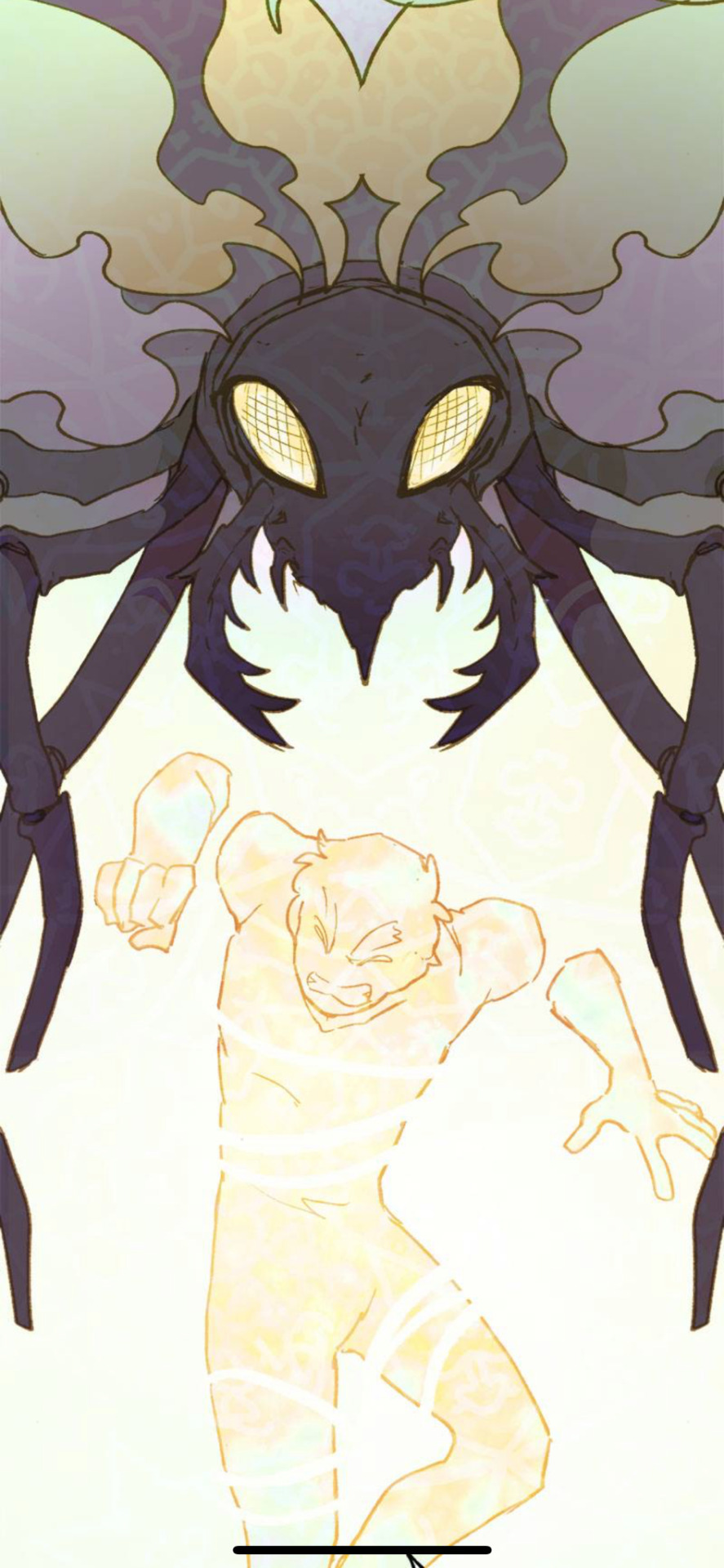
this isn’t a spider.
it’s convincing enough at first with its behavior. the framing alone makes you want to think it’s one (the way it hangs & appears to dangle above its prey)
but it’s got compound eyes. and only two of them. it only has six legs instead of the signature eight. it tries to look and behave like a spider, tries to convince us that it is one, but it’s just… not?
now I’m willing to suspend my disbelief if this is an art decision factoring in, as it opens up the potential for fascinating inspection on how this universe operates. because spiders famously have multiple sets of eyes, right? it’s one of their defining features! what kind of world could exist that would be able to impose such a harsh limit of eyes onto a spider of all creatures?
a world with the ah’kon would.
i find it interesting that—if this is an artistic decision, and this creature we see is in fact a spider—the deliberate choice to only allow it two eyes gives us a very fascinating look into how the spirit world operates. planting the idea that even native beings of that world do not possess the amount of eyes necessary to see into anything beyond it. because two eyes are limited. in humans, and in this creature.
the only people capable of seeing into both are the ah’kon, and the ah’kon possess more than two eyes. one of which, very pointedly, is incapable of blinking.

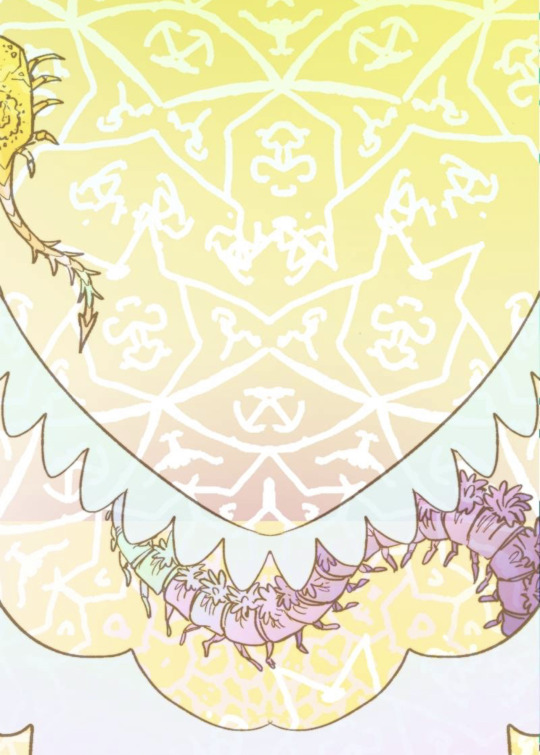
the spirit world appears to be inhabited by bugs and fish. we get a glimpse of a fish at the start of chapter 3, and we get a hint of a centipede at the very start of this chapter’s sequence (as well as some other arthropod-looking creature that I’m unsure of)
well. one key feature of bugs and fish, is that their eyes are incapable of blinking. they have no eyelids! these spiritual creatures have the same characteristics in their eyes that the ah’kon do in their third one. human eyes—earthly eyes—on the other hand, can fully close. and the ah’kon have the ability to do that with their lower set.
however, while they do possess eyes from both worlds, each can still only see into their respective ones, never the other.
so it’s interesting that a spider-like creature would be very pointedly limited to only two, unblinking eyes. it drives home the point of just how separate these worlds are. however powerful this creature may be, it is still held back inside its plane of existence. it doesn’t have a place on earth.
well, then what does that mean for this?
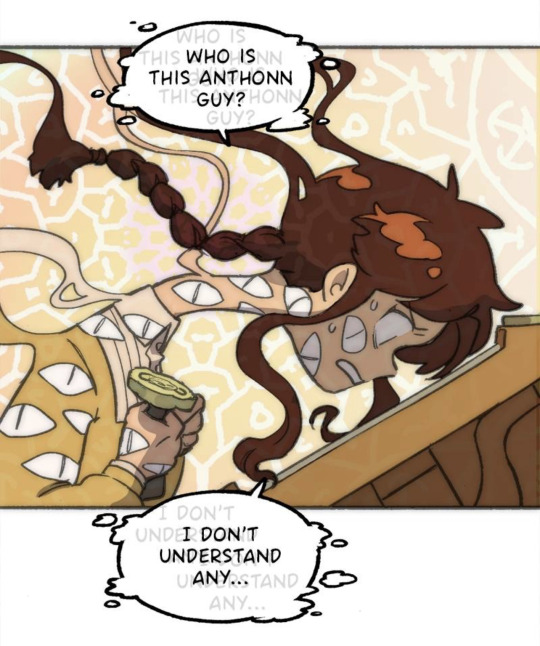
i honestly don’t know yet. it’s very clear that eyes are a running motif in this story; they have been since the very start. but this tidbit of information that we’ve received via the “spider” adds more to the puzzle & gives us a little more understanding into how all of the pieces could fit together in the future. :D
#scarf.txt#marionetta#marionetta webtoon#absolutely fascinating chapter that is quite frankly catered to me specifically as a guy who adores bugs#i hope we get to see more of these creatures they’re so cool
75 notes
·
View notes
Note
Hi!
I’m writing a fanfic in which the characters go to various mythical places. I want to have them go to Alomkik, a place in Abernaki mythology. However, information online seems to be scarce about it, and I’m well aware that Native and First Nation mythology has historically been butchered for entertainment. Not asking you to do research for me (obviously not! That’s my job!) but do you have any advice? I really want to do this respectfully or not at all.
Characters Visits Place from First Nations Myth
Here's the bottom line: unless you are yourself First Nations, I would not even attempt this. Not only do you risk cultural appropriation, but the fact that there is so little information available about this location... and the fact that it's associated with a legendary bird spirit, concerns me that Alomkik may have spiritual and/or deep cultural significance and firmly off the table for use by people who are not First Nations. Additionally, the lack of information available would force you to have to fill in the gaps, and I'm sure you can see the issue with someone who is not First Nations, and who is not rooted in Abenaki culture, filling in the gaps of Abenaki spiritual mythology.
Other things to consider: since you mention this is fan-fiction, if the source material has used or commonly uses places from Indigenous cultures, it's possible there are people from those cultures on the writing staff. It's also possible they just don't care and are blatantly appropriating from those cultures, but that doesn't mean you should or that it's okay for you to do it, too. Instead, if you need a mythical location in that same general area (what is now Central Maine), you could make up a fictional colonial settlement that disappeared (like the Roanoke Colony in what is now North Carolina) and give it some interesting mythical legend. Alternatively, you could create a myth around a fictional Viking settlement... Vikings are known to have settled an area 700 miles away (L'Anse aux Meadows in Newfoundland and Labrador) and some scholars believe it's possible the Vikings could have explored what is now inland Quebec via the St. Lawrence River, and as far south as Manhattan Island. That gives you plenty of realistic leeway to have a Viking settlement in inland Maine... though, you may need to look at the viability of available rivers for conveying boats far enough inland for your needs. Or, you could maybe create a legend where a particular member of a Viking exploratory group splinters with the main group and takes a small number of people as far up river as they can go, then further inland on foot until they arrive at the necessary destination. Another option would be the... dare I say it... Knights Templar... who are popularly believed to have traveled to North America to hide treasures taken from the Holy Land. My point is, there are lots of opportunities to crate an interesting mythological location using European folktales, myths, and legends rather than appropriating from Indigenous culture.
Happy writing!
•••••••••••••••••••••••••••••••••
I’ve been writing seriously for over 30 years and love to share what I’ve learned. Have a writing question? My inbox is always open!
LEARN MORE about WQA
SEE MY ask policies
VISIT MY Master List of Top Posts
COFFEE & FEEDBACK COMMISSIONS ko-fi.com/wqa
22 notes
·
View notes
Note
https://olderthannetfic.tumblr.com/post/738048040266563584/httpsolderthannetfictumblrcompost73791430836#notes "If you think you know more as a Greek you inherently know more about your ancient mythology, just from those facts alone, than a non-ethnic-Greek with a postgraduate degree in studying Greek mythology," You really really had to go for one of the most specific reaches ever. "Ok but do you know as much as a person who paid money to get a degree in knowing about myths tho???" Who said that they know more than someone who studied the myths? Who?
This doesn't even cover the issue talked about that people who grew up in a culture have different emotions and feelings tied to it, than a non-Greek. Someone could have graduated Greek mythology and would still never know or understand the experiences of Greek people who got removed from their own history and myths because they were considered too subhuman to fit the lore of their own history. There's more to understanding something beyond just having a degree. And to no one's surprise, POC Greeks also exist, mixed Greek exist, people who were raised with the Greek culture.
And might I remind people, this started because an Anon asked Greek people from Greek about incest and bestiality in Greek myths. This btw, never excluded any of the previously mentioned groups, it only specified that it was for Greek people from Greece.
Why are you all making it about like blood and soil and ethnonationalism? Are you so afraid that some people have feelings about the culture they themselves simply grew up in you just need to bring in random hypotheticals to claim everyone else is a bad person?
You know someone can study the history of a place, and still never understand how the people from there feel about their own history. It just means you learnt about the stories and myths in more depth than maybe the average person does in an academic space.
Someone completely unrelated who studied this can just be quiet about it, if they weren't Greek it's just an interest they had. They have no deeper ties to it beyond that. Meanwhile a Greek person can't just turn off their actual culture, and their own association with it, unless they want to cut of a part of their identity.
People of certain races and ethnicities and countries and cultures can't just turn off their ties to the cultures they grew up in or with, it's something that shapes you. If you study something as an outsider you probably will never understand that specific feeling. You could study Japanese culture, and you still wouldn't have the same connections to it as someone who lives and is raised in said culture. You're looking at it through an academic lens. Doesn't school teach you that? You're learning the information, not the feelings and emotions. Not being American doesn't make you any less ignorant. You can also be ignorant. Being American also doesn't make someone ignorant. I'm going case by case, you act ignorant, you're ignorant. Fuck whatever place you came from, this wasn't about you, or your hypothetical post-graduates.
And to add on: Stop shitting on Americans as a group. Some Americans act ignorant, call those out. Americans aren't any more of a monolith as the entirety of Europe, Africa, Asia, Oceania, etc. Just like everyone else can be ignorant, you should specifically focus on the actual people acting and being ignorant.
--
15 notes
·
View notes
Text
Bigfoot and Bears
People have been fascinated and perplexed by the myth of Bigfoot for many years. Bigfoot is a mythical, ape-like monster that is rumored to live in North American woodlands. Despite many sightings and multiple claimed interactions, concrete proof remains elusive. People may mistake bears, particularly the American black bear, for Bigfoot, which could explain many of these sightings. Numerous elements, such as bears' physical traits, actions, and the places they live in, support this notion. Bears sometimes resemble Bigfoot's reports, particularly when seen from a distance or in low light. Standing on its hind legs, an adult black bear can reach a height of more than six feet, matching the mythical creature's proportions. Bears can have a very human-like silhouette when they are standing upright. Their shaggy fur, which can resemble a huge, hairy biped akin to eyewitness reports of Bigfoot, emphasizes this likeness even more. People have also observed bears walking short distances on two feet, particularly when they are enquiring or trying to get a better look at their environment. One could easily confuse this activity with the gait of a bipedal hominid.

Bear habitats also overlap quite a bit with places where bigfoot sightings are frequent. North America's hilly regions, dense forests, and large wilderness areas host strong bear populations. These areas are ideal for both bears and alleged Bigfoot encounters because they provide plenty of resources and cover for the animals. The possibility of misidentification increases because hikers, campers, and hunters in these areas may not always be familiar with the local animals. Furthermore, the Bigfoot tale may have its roots in bear behavior. Bears are often elusive and reclusive creatures that would rather stay away from people. This evasiveness may result in short, transient glimpses, leaving much to the imagination. Bears, when threatened or provoked, exhibit aggressive postures or vocalizations, further fueling bigfoot rumors. People may perceive these behaviors as threatening or unearthly. It is impossible to overlook the influence of psychological and cultural elements. Deeply rooted folklore and the power of suggestion can affect how people interpret unclear information. If you hear a rustle in the bushes or see a dark figure in an area where Bigfoot legend is common, you could easily attribute it to the mythological creature instead of a bear. Due to the well-known limitations of human perception, people frequently see what they desire or anticipate to see while under stress or in unclear circumstances.

We now know more about the ecology and behavior of bears because of technological advancements and growing public interest in wildlife. We gain a deeper understanding of these animals' lives through the use of drones, trail cameras, and other monitoring devices, which often capture actions previously considered uncommon or unique. By demonstrating that the claimed creature was, in fact, a bear, these technologies have also refuted several Bigfoot claims. Even though Bigfoot's appeal is still great, it's quite likely that many sightings are just bear misinterpretations. We can dispel the mystery surrounding Bigfoot and foster a deeper respect for the actual wildlife that inhabits our planet by recognizing the parallels between bears and the mythical being they frequently confuse with. More research and unbiased investigation may not only solve the enigma surrounding Bigfoot, but also inspire greater reverence for the animals that inhabit our forests.
#bears#grizzly bear#black bear#bigfoot#sasquatch#north american cryptid#cryptids#cryptozoology#cryptid#bigfoot art#bear art
3 notes
·
View notes
Text

By: Paul Mulshine
Published: Dec 28, 2015
Around this time of year, various journalists run sanitized versions of the creation myth of Kwanzaa. They report that it has roots in African culture and overlook the fact that founder Maulana Karenga has a past that discredits both him and his made-up holiday.
So, it was interesting to see this article in which the writer notes that Kwanzaa is even less popular than Festivus, that holiday made up for the Seinfeld show.
Click here for the in-depth article I did for Heterodoxy Magazine on Kwanzaa back then.
Below is my 2002 column on the subject:
--
ONE OF MY READERS called me the other day to inform me that the public schools in New Jersey aren't allowed to celebrate Christmas but are celebrating Kwanzaa.
This is intriguing. Christmas celebrates the legacy of Christ who, by all accounts, was a nonviolent man who believed that people of all types could learn to live in peace. Kwanzaa celebrates the legacy of an extremely violent man from California who has dedicated his life to spreading dissension among the races.
More on that later. First let's deal with the question of why schools can propagate a belief in Kwanzaa but not Christmas or Chanukah. For an answer, I called Ed Martone of the American Civil Liberties Union.
''Kwanzaa isn't a religious holiday," said Martone. "It's a cultural holiday. It doesn't have the same restrictions as Chanukah or Christmas."
I'll grant that there is a certain logic to the view. After all, once the government gets involved in religion, the potential conflicts among Catholics, Protestants, Jews, Muslims and atheists are so complex that perhaps we are better off avoiding them altogether.
But by that same logic, the public schools should not be pushing certain cultural practices. And the schools especially shouldn't be endorsing cultural practices created by a character with the beliefs and the background of Ron Karenga.
It is not easy to get a hold of the facts about the background of the creator of Kwanzaa. In fact, it is nearly impossible. The history of the founder of Kwanzaa has disappeared into an Orwellian time warp.
If you look up the name "Ron Karenga" on any of the many newspaper data bases that are available these days, you will read a glowing account of a deep-thinking philosopher who comes across as a sort of jolly Father Christmas for African-Americans.
You won't find any reference to murder or torture. Yet murder was a specialty of US, the paramilitary organization that Karenga ran in Los Angeles in the late 1960s.
As for torture, Karenga took that more personally. The accounts of his personal role in a particularly sadistic episode of brutality have been largely lost to history.
The episode seems to exist only on a few microfilmed pages of the Los Angeles Times. It took two days of research and phone calls to track them down.
Here is an excerpt from an article headlined "Woman describes two days of torture" on the May 1971 trial of Karenga for torturing two dissident members of his group:
''Deborah Jones, who once was given the Swahili title of an African queen, said she and Gail Davis were whipped with an electrical cord and beaten with a karate baton after being ordered to remove their clothes. She testified that a hot soldering iron was placed in Miss Davis' mouth and placed against Miss Davis' face and that one of her own big toes was tightened in a vise. Karenga, head of US, also put detergent and running hoses in their mouths, she said."
Karenga was convicted and served more than three years in a state prison.
This was not an isolated incident. In 1967, Karenga was accused of having his thugs beat up a student who asked him an impertinent question at a college forum.
In 1969, US got involved in a struggle with the Black Panthers for control of the black studies program at UCLA. All involved carried guns on campus. The US guys were quicker on the draw; they killed two Panthers in a shootout at the student center.
It would be nice to say that after Karenga got out of jail in 1975 he repented, saw the error of his ways and invented Kwanzaa as a means of atoning for his past.
Nice, but untrue. Karenga has never atoned for his thuggery, probably because no one ever asked him to. And his sole concession to repentance was his 1975 conversion to Marxism. For him, this was considered to be a sign that he had moderated his views.
Karenga invented Kwanzaa at the height of his gang days, in 1966. And he made it up not to bring peace among the races but to divide them. That's why he placed this alleged "harvest festival" in competition with Christmas, which he derided because of its ties to the hated capitalist system.
It may be true that Kwanzaa has evolved into a ceremony that has importance to a great number of well-intentioned people, people who have no knowledge of its creator's questionable history.
But Karenga himself continues to champion the holiday as an example of what he terms "cultural nationalism." This is the view that black people are a separate "nation" within a hostile country. During a visit to Newark in 1987, Karenga defined America as "an insane, socially decaying society." "We need a value system and a support system . . . because the world is organized against your Africanism," he told Newark residents.
Karenga remains a leading spokesman for the multicultural movement, a movement based on the idea that Americans should emphasize their differences rather than their similarities.
The idea of Kwanzaa fits firmly within multiculturalism. And however you feel about multiculturalism, you must admit that it is a political movement and therefore one that should not be supported with tax dollars.
As for Karenga himself, he should be given all the respect due a convicted torturer.
Call me an old fuddy-duddy, but I believe that once a man inserts a hot soldering iron into a woman's mouth, he should be excluded from public discourse for eternity. I may be wrong, however. Certainly, the people in California don't seem to share this view.
Karenga is now a professor at California State University in Long Beach.
That's California for you. By that standard, there's a university presidency waiting somewhere for Charles Manson when he finally gets out.
COMMENTS:
Note that I'm not arguing here that people shouldn't celebrate Kwanzaa. It's a free country and people can celebrate what they want.
I'm arguing that the media should not cover these celebrations without including the key facts about its founder. That's just basic journalism.
==
Why the Vice President of the United States feels compelled to pretend that her family has a long tradition of celebrating a fake holiday that apes African tropes and Judaism, concocted by a brutal felon and sociopath, and which was invented when she was two years old is a question worth seriously contemplating.
#Ron Karenga#Kwanzaa#Happy Kwanzaa#fake holidays#holiday of torture#Kamala Harris#seven principles#cultural nationalism#black nationalism#black separatists#neo marxism#religion is a mental illness
11 notes
·
View notes
Text
Reasons why I think my theory that Lucy isn't the strongest listener since Fittes, she's just the only one who's tried to listen, holds water even if it probably isn't true.
1. We see at the start of book 4 and throughout most of the series how little agency and autonomy most agents have. If the goal given to them is to restrain the source and not consider the ghosts as anything other than an enemy, why would they try to listen and talk to them?
2. We know that Lucy's listening abilities are deadened by salt, iron, lavender, etc. If most people don't try to communicate with the ghosts outside of safeguards, it makes sense that mostly they wouldn't be aware that a conversation could be had with the weaker ghosts because Lucy also struggles to talk to type 2s when the safeguards are up. As it was, she only got the idea to start trying after she talked to Skull. Which brings me to point 3:
3. The idea is that type threes are essentially myths, but Fittes was clearly keeping Skull as an oddity, crucially, rather than incinerating the skull as is done to the majority of sources. Why would they keep this skull in particular if they didn't know anything was special about it? This potentially indicates they knew more about how powerful it was than they let on, which fits with the very strong themes of corruption, intrigue, and deception among the ghost hunting agencies. It would perhaps make sense then that, for unknown reasons, the agencies are suppressing the information that any number of listening agents could potentially talk to type threes, as well as potentially attempting to keep the fact type threes exist outside of Marissa Fittes' diaries under wraps.
4. Type threes are clearly rare anyway, even if they aren't being kept secret, and they're very powerful. It's possible many listeners who faced them simply died. It's a very dangerous situation to be in.
5. Without the knowledge that ghosts can be conversed with caused by the interaction with a type three, there would be no reason for Lucy or any other agent to attempt to put themselves in danger by trying to talk to type twos.
So, I think it's perfectly possible Lucy isn't the most powerful listener since Fittes, but rather the only one with the particular set of circumstances of a. Having a Type 3 to hand and b. Not being controlled by an adult supervisor or a larger agency, which would allow her to make that discovery. Mostly I'm interested in this because it fits with the larger themes of secrecy, control, conspiracy and deception among those placed in charge of the Problem, and the themes of the power of the individual being suppressed by the institution. It would make sense thematically, then, for any number of listeners to possess this power, but for all of them to have the opportunity to discover it taken away from them.
#lockwood and co#lockwood & co#no listen I'm sooo interested in this concept which is why I numbered it this is a really important point to me#Idk I'm only part way through book 4 but yeah!#I just think!!!#because IT FITS WITH THE THEMES SO SO WELL!!!!
52 notes
·
View notes
Note
Looking at your interesting — and always high quality — posts on the “Copenhagen school”. It seems we share similar concerns about later datings of the final redaction of the Torah and other Hebrew texts, to the 3rd and even second century BC by Gmirkin and others. How much do you think this reduces ancient Near Eastern literature to just variations on the classical Greek literature templates?
Thank you for your ask and for your kind words on the quality of my posts.
Concerning the substance of your ask, I am not a Biblical scholar, so I cannot speak with some authority on such topics. I posted about the "Copenhagen school" because I found its positions very interesting and thought provoking. But I think that most (non fundamentalist or "Biblical maximalist"...) Biblical scholars today place the composition of the bulk of the final version of the Hebrew Bible (the Old Testament for Christians) in the 5th century BCE, prior to any serious contact of the Jews with the Greeks, with the exception of the Book of Daniel, of some other pseudepigrapha and perhaps of the Book of Judith, of the Book of Esther and of Qohelet, which are placed in the Hellenistic period.
Now, even if the "Copenhagen school" and Gmirkin are right about the datings of composition of the final version of the Bible, so that we could accept the possibility of a Greek influence on it (other than the influence of Greek philosophy and culture on choices of translation from Hebrew to Greek and on the interpretation of the Bible, about which there is not much doubt), I think that it would be totally wrong to say that the Hebrew Bible, let alone ancient Near Eastern literature in its entirety, could be reduced to just variations on the classical Greek literature templates. In fact ancient Near East had a very important literary tradition which predates for many centuries even archaic ancient Greek literature, although of course the truth remains that the Greeks developed (mostly independently) and perfectioned pre-existing literary genres like epic and didactic and lyric poetry and revolutionized literature by creating new genres, like drama, historiography, rhetoric and philosophical dialogue and treatise. Personally I tend to see the Hebrew Bible as part of a broader Near Eastern religious and literary tradition, although there is for sure also much originality and new beginnings of crucial importance in content and form in the Bible.
On the other hand, even if the "Copenhagen school" is wrong in its main position, I think that their approach has the important merit that it drew attention to the analogies and similarities existing between ancient Greek literature and especially Herodotus' Histories and the Hebrew Bible, a field of research that I find very interesting.
But again this should not make us forget the essential differences that exist between these works. To focus only on the relationship between the Bible and Herodotus, which preoccupies the most scholars of the "Copenhagen school" and others who could be affiliated with it, even those of the books of the Bible which do not just expose various "myths of origins and of founders", but relate the history of a non mythological past and contain often (although for sure not always) accurate information, especially on the history of the two Hebrew kingdoms, are in fact above all hierohistory. I say this because these books are seen by their community as divinely inspired and the historical events are interpreted (and in not few cases even distorted or invented) in them exclusively on the basis of the relationship of the God of Israel with his people and of the respect or transgression by the latter and its leaders of the "pact' dictated by the former.
On the contrary, Herodotus presents himself as an investigator of the past who takes individual responsibility for what he says and adopts some explicitely stated methodological principles in his research. Moreover, although he believes in the (mostly indirect) intervention of the divine in the course of events and adopts a "tragic" conception of history, according to which the powerful and arrogant are eventually punished for their hybris, he pays mostly attention to and investigates the natural and above all the human causes of events (geography and environment, chains of interactions between actors, the conflict between the desire for domination over others and the aspiration to freedom, the necessary limits of imperial expansion, the tension between the common human nature and the vast diversity of cultures between human groups, institutions and their influence on collective and individual characters, military techniques and equipment, good or bad decisions of the historical actors in given circumstances) and tries to discern some patterns which underlie history.
6 notes
·
View notes
Note
For the fanfiction ask game: 17, 18, 25, 49, 51!
Citrus! Thank you so much for the asks! If anyone is looking for Digimon Adventure and 02 fanfics, you can read mine on FFN or on AO3 if you are logged in <3
17.) Do you have a writing routine?
A few years ago, I was big on finding a place with a closed door and lighting a candle (partly for vibes, partly to discourage wandering off). But these days, I try to be as informal as possible, so that it's easy to write anytime, anywhere. Sometimes, all you can do is get 15 minutes of copying edits into your draft or jotting down ideas, and those 15 minutes are way better than nothing.
18.) Do you enjoy research? Which fic of yours required the most research?
I enjoyed research a lot more about 10 years ago. Search engines are a nightmare these days! I tried to research courtship in Japan and France in the 1930s for Puits d'Amour, and there is. Nothing. Searchable on Google in English for anywhere except the states and the UK. I ended up purchasing some books on the history of courtship that are, sadly, still very US and UK oriented, and just. Making it clear in my fic that the countries portrayed are fictional, largely in part bc I just could not get my hands on the info I needed.
I did some medical research for Seeking Resonance that was really interesting for me at the time, and oddly, came up in my career just last week! I was floored lol!
25.) What’s your favorite part of the writing process (worldbuilding, brainstorming/outlining, writing, editing, etc)?
I seem to be comparatively light on the worldbuilding and outlining. I love writing because flow state feels amazing and I love editing because it's challenging play. Often, I find that what I want to say evolves from the moods and ideas that occur during flow state. It's been interesting, because over the 12 years of publishing as ahiddenpath, I can see reflections of what I was dealing with personally at the time, and how I resolved that strain with the story. Of course, this kind of writing demands more editing later, as it's so freeform. But I enjoy editing, and I believe my love of writing and need to write are strongly connected to the fact that I use writing to deal with things, to understand myself, to challenge myself, and to grow.
49.) What fic of yours would you say is the best introduction to you as a writer?
How I write and how I think about writing is always changing and evolving, so I suppose my more recent fics? But for the digimon fandom specifically, I usually say After August. Like most of my stories, it's a character-based drama. Specifically, it's about the Adventure Chosen dealing with the loss of their partners and the difficulty of shifting from life as a Chosen in the Digital World to life as kids on earth. Each of them copes in a resoundingly individual way, and they reach out to one another to offer what comfort and support they can.
My works tend to be about people grasping for self-growth and dealing with their demons. They usually aren't plot heavy, although I've been pushing myself to explore plot-based stories recently.
51.) Does what you like to write differ from what you like to read?
One of my closest friends has a master's in literature, and she obligingly wrote me a list of what is... How do you say this? Expertly??? Considered the best literature available in the English language. I've spent the last several years feasting on that, hoping to learn and grow. So, um. My writing can't compete, lol!!!!!
But lately, I've gotten back into reading purely for fun, rather than growth/challenge/experience. I devoured three modern Greek myth retellings in like a three week span, and I have another waiting at the library for me to pick up! Typical, lmao!
The sudden contrast made me notice that, at the risk of sounding snobbish, books written because the narrative is fun, imaginative, and joyful to behold are a different experience than books that encapsulate some aspect of humanity with painful, exquisite, brutal clarity. It's like, hello reader, would you like enjoyment or an existential crisis???? It's been a privilege and a joy to grow from these uh... Literature degree required reading list books. But man it's fun to eat a novel like it's cake!!! OM NOM NOM MORE PLEASE!
I'm not sure if that answered the question at all, but I guess recently I am trying to explore books that I find delightful rather than personally challenging.
Thanks for the asks friend, they were a great distraction from some difficult stuff <3 I really appreciate it! I'm happy to take more if anyone is interested.
#ask hidden#writing#writing questions#fanfiction#fanfiction ask game#digimon#digimon fanfiction#digimon adventure
5 notes
·
View notes
Text
Cienie’s take on Mandalorian Culture: Kad Ha’rangir and mandalorian traditional weapons, p. 5
part 1 — part 2 — part 3 -- part 4
Caution: I have never personally played The Old Republic MMORPG game and all my knowledge about Mandalorians of that era comes from tie-in material including those published on dedicated to SWTOR sites and watching playthrough videos, especially of the last patch, Legacy of the Sith. Keeping that in mind, let’s wrap up the final part.
The Old Republic MMORPG game takes place a few hundred years after the regime of Mandalore the Indomitable, The Ultimate and the Preserver (Wookiepedia claims the story of SWTOR currently covers the era of 3643–3626 BBY). For the first(?) time an in-universe source contemporary with the events taking place directly mentions Kad Ha’rangir and praying practice:
The Fall of Mandalore the Vindicated Firsthand account from Ralia of Clan Lok: The Skytroopers surrounded us. Two dozen, blasters aimed at our heads. We had already begun our death roar. And then Mandalore the Vindicated cut through them, scattering their metal parts. He ordered us to rejoin the clan and leave the Skytroopers to him. But the droids had called for backup; suddenly, dozens were swarming him. Mandalore dismantled them two at a time with a war cry like thunder. They kept coming, waves and waves, till we could no longer see him. I started to charge forward, but Droga stopped me. “He’s already gone.” He was Ardus Lok. My brother, our Mand’alor. And he fell to machines. He will not be honored. I pray to Kad Ha’rangir this pointless war will end soon.
This account gives us a lot of interesting details about the Ralia of Clan Lok’s mindset. On one hand, “he fell to the machine. He will not be honored” line fit with what game itself presented by Torian Cadera

and Khomo Fett's mocking saying

Which implies she and similar minded warriors followed very harsh rules according to which dying in battle against machines may bring dishonor - even if Mandalore sacrificed himself to save his people, as Ralia herself said: He ordered us to rejoin the clan and leave the Skytroopers to him.
However the author of this account didn’t pray to Kad Ha’rangir to acknowledge and/or have mercy on the soul of the “dishonored” clan brother but prayed for pointless war to end soon. Which is surprising, given that War was a central part of her culture - approximately three hundred ago, Taungs and Neo Crusaders considered War to be divine and SWTOR’s lore object outright says “War is the Mandalorians’ way of life”, while describing Mandalorians as “trained from birth to fight in battle”, who “embrace conflict and admire strength” and “believe confrontation is required for growth — on the personal, as well as the cultural level."
Mandalorian praying for war to end seems to be acting against the most basic principles on which the whole warrior culture is built. Even more surprising is the fact, the prayer was said to Kad Ha’rangir, the god known as Destructor who demanded from his followers to face challenges and trials in the first place and not, for example, to Arasuum, the god supposedly opposite to Destructor. And yes, the Mandalorians: People and Culture and Death Watch Manifesto call Arasuum the god of stagnation and idle consumption however in the traditional understanding of myth, opposition to destruction wouldn’t actually mean prosperity as time not dominated by war?
Showdown on Ruhnuk (included in Legacy of the Sith, 2023) went even further with the religious aspect of Mandalorian culture by introducing the clan Ha’rangir, whose members are said to be descended from the god Kad Ha’rangir himself. Within the game itself, this information is passed to player by Lane Vizla:

"Clan Ha'rangir claims they 're descended from Kad Ha'rangir, an old Mandalorian god of destruction."
SW:TOR provided also a codex entry for Ha’rangir Clan (x):
Named for Kad Ha'rangir, the ancient Mandalorian god of destruction and bringer of change and growth, Clan Ha'rangir was founded by Mandalorians who believed their people were being weakened by cowardice and inaction. The clan began a bloody expansion called "Ha'rangir's Path" in the latter half of 3732 BBY. Their early success encouraged more raids and occupations, which earned the clan a fortune in resources. This vast war chest sustained Clan Ha'rangir during the decades of reactionary conflict that followed. Their empire building peaked in the 3600's and slowly declined as newer generations of Clan Ha'rangir avoided the front lines, preferring instead to manage and expand their wealth. Once formidable conquerors, Clan Ha'rangir's power today resides in the credits they command, rather than their military might. Some within their ranks, however, are questioning their role within the galaxy, perhaps yearning for a return to their expansionist ways.
Lane Vizsla describes this clan as “old money, with an even older name”

However Lane notes also how the fame, prestige and credits corrupted those Mandalorians, including current leader, the Kur Ha’rangir.

Decades of that kind of notoriety, power, and credits have given them quite that inflated self-image.

He does whatever he wants - no matter how dishonorable - and his name and his money pay for everyone to ignore it.

They consider it an insult if you don't recognize their prestigious history. They consider it a threat if you don't give them the respect they demand.
Granted, Lane Vizla isn’t an objective source, as she holds personal grudge against Kur Ha’rangir for killing her brother in an unfair duel over a trivial matter[12], yet what game presented on screen (Kur’s treatment of basilisk war droids) so far supports Lane’s claim. Even Codex entry for leader of Ha’rangir clan (x) highlight his egotistical and arrogant nature:
Ruthless, arrogant, and egotistical, Kur Ha'rangir embodies all of the traits that the members of his clan, Clan Ha'rangir, consider important. Claiming to descend from Kad Ha'rangir, the old Mandalorian god, Kur sees his clan as the supreme embodiment of Mandalorian strength and power. To reflect Clan Ha'rangir's status, Kur believes that he should possess the strongest and most powerful weapons. Although Basilisk war droids--the infamous Mandalorian mounts that wreaked havoc across the galaxy during the Great Sith War and the Mandalorian Wars--are exceedingly rare, Kur Ha'rangir has no interest in preserving them for future generations. His only goal is to collect and continually improve the best of them, even if it means sacrificing the increasingly limited number of Basilisk droids for their parts. As the number of available Basilisk droids dwindles, Kur has turned his attention to learning how to build the war droids--a craft that was lost when the droids' original creators destroyed their own planet. Legend tells of beacons, full of schematics and construction plans, that were scattered across the galaxy when Basilisk was destroyed, and although Clan Ha'rangir has pledged themselves to fight alongside Heta Kol and the Hidden Chain, Kur has not let their desires interfere with his own obsession.
There are plenty of conclusions that can be drawn from the above sources. The most important one is that Kad Ha’rangir is known as an old Mandalorian god of Destruction and whose importance remains strong enough to allow the “descendants” bathe in his glory solely for supposedly sharing the same blood and surname. We still can’t be sure if original Mandalorians worshiped this deity under this exact name (or if even knew him at all), but if Kad was part of Taung mythology, then we can assume the mythological knowledge (religion) was passed down to newcomers before Taung died out. This is actually quite an interesting detail in regard to religious reformation that happened before The Sith War, when original Crusaders are said to change their customs and start worshiping War itself.
The second vital information is how Mandalorian society has changed by the last three to four hundred years. For one, a clan like Ha’rangir isn’t held at this point in respect due to members’ individual deeds or military might but solely for supposedly having a prestige ancestor and money to cover for their dishonor behavior. Though we do not have that many sources about original Mandalorians, I think it is safe to say clan Ha’rangir is the beginning of the emerging aristocracy while also an antithesis of Taung warrior society. Especially in the matter of equality of clans, personal honor (prestige) and money.
Taungs, as far as we know, respected hierarchy but their social structures were built on warriors’ personal achievements not who their forefathers were. They did seem to hold past ancestors (clan members) in high regard[13], as at some point in the past they renamed themselves from Shadow Warriors to Mandalorians in honor of their legendary “warrior king”, Mandalore the First. However no one so far claimed to be a direct descendant of said leader or gods nor the leadership was passed down on such a basis. The title of Mandal’or is outright stated to not be democracy nor hereditary bestowen - which means only the person who dared to take the title (responsibility) and proved their worth may lead other warriors. This approach to the leadership was mentioned in SWTOR tie-in source, the The Old Republic Encyclopedia:
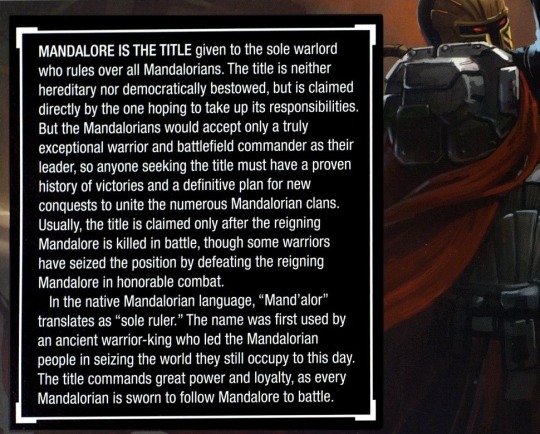
and summarized by Canderous Ordo: “When our leader falls in battle, the most worthy takes his place”. (Star Wars Miniatures)
Similar approach could be seen in regard to hierarchy between clans and its members. For example, Galaxy At War Sourcebook describes Taung society as “clan-based nomadic culture” in which ”veterans of successful battles are held in high regard, to such an extent that they are de facto leaders of their communities. Only the leader of all the Mandalorians, known simply as Mandalore, holds greater sway with the clans.”
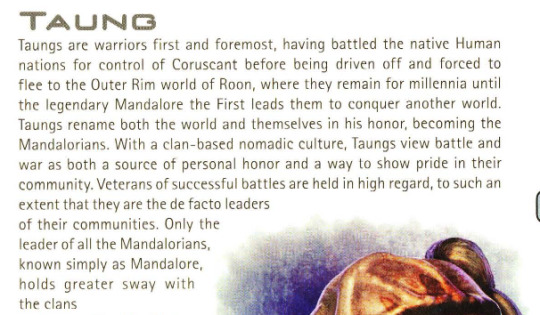
while SW:TOR Encyclopedia states “Although clans may have ties or rivalries with other clans, there is no formal hierarchy. All clan chieftains report directly to the Mandalore”.
(The lack of formal hierarchy wll change overtime, as some old and/or powerful mandalorian clans like Vizsla and Kryze turned into Houses. The sources so far did not provide enough data about inner workings of said Houses, although Sabine’s introduction in Rebels: Protectors of Concord Dawn [S02E13] as “I'm Clan Wren, House Vizsla” implies other, lesser(?) clans are subject to them. Similarly, House Kryze at some point became officially acknowledged as the Royal Family that ruled Mandalore before and during the Clone Wars. Simultaneously, the number of clans is not constant and limited, as sources provide examples of new clans formed during different eras.)
At the same time, the Mandalore, clan leaders and veterans - the broadly understood "ruling class" - may be challenged by anyone and according to the law, the honorable duel will officially settle the conflict[14]. This law apparently survived to modern times as could be seen in
Death Watch Manifesto: “to ensure we would be led by the most powerful, we decreed that any warrior could challenge the Secret Mandalore for leadership of Death Watch”

and The Clone Wars TV animated series when Maul challenged Pre Vizsla to a fight over control of Mandalore & Death Watch:
Almec: “Clearly you are powerful, but how can two of you overthrow Vizsla and his supporters?” Maul: “Vizsla is a soldier and, like every soldier, he is bound by honor. I will challenge him to single combat in front of his men. He will not deny me.” Almec: “Hmm. If you defeat him, according to the ancient laws of Mandalore, his soldiers will be honor-bound to follow you.” [TCW S05E15: Shades of Reason]
All of this implies that Mandalore and even the highly renewed veterans do not stand above the law - and maybe, ironically, are even more bound to follow it, as their honor is at stake.
Now, Ha’rangir clan is said to get away with dishonorable act during an official duel because of the religious connection and money and in all fairness, this speaks a lot about Mandalorians of that time. The roots of this corruption however reach the end of the Mandalorian Wars and the following decade(s) which brings me to another vital point. How exactly Ha’rangir clan got their fortune?
Lane Vizla described members of said clan as “old money with an even older name”. while Shae Vizla further explained:
Player: Clan Ha’rangir? Shae Vizla: I figured we’d see them around. Like I said before, they’re old money. Many clans got rich from plunder during the Mandalorian Wars generations ago. They want those days back, and Heta’s the answer.
If we agree that Ha’rangir clan got rich from plunder during the Mandalorian Wars, the clan dates to at least the last phase of Taung era (and Lane suggests the clan is even older than that). As much as it is true that Crusaders and Neo-Crusaders raided and robbed many planets, Taungs weren’t exactly focused on material wealth. Yes, they prized advanced technology and generally understood weapons were always at the top of list to steal, but money and similar goods? KotOR Campaign Guide states that “trade within Mandalorian communities is based on barter, with jewelry and precious metals used as portable commodities alongside weapons and armor” and that Mandalorians were familiar with galaxy currency however beside that one paragraph, the traditional culture didn’t seem to hold material goods other than an armor in any real regard, as only personal achievements allowed warrior to rise in the social hierarchy.

Thinking about this matter, KotOR tie-in materials allowed us to dwell into the Mandalorian mindset and majority if not all named Mandalorian characters showed no real concern over the money.
In KotOR: War, new recruits were provided with armor and weapons, warriors did not complain about living in harsh, frontline conditions even while raising children. Ko Sornell's advice to a newcomer (Zayne) was “find some wall to lean against. During invasions we sleep in armor. You'll get used to it” [KotOR:War #2]
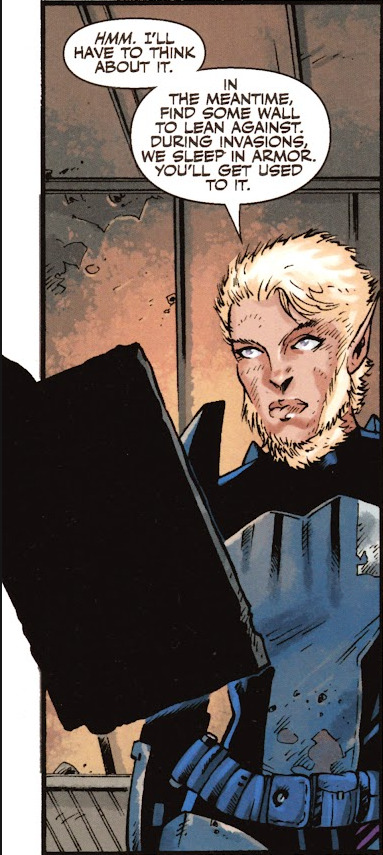
Another example comes from Interference short story taking place in early 3963 B.B.Y. When Mandalorians were faced with republic propaganda broadcasting on their communication frequency, taunting with luxury, even talking about how the Republic has “Real beds. Running water” in contrast to mandalorian camps and finally promising wealth:
And it is an offer. They say that Mandalorians deal with things in a Mandalorian way. Well, the same is true of the Republic. And what is the Republic at heart, if not first and foremost, a vehicle for the enrichment of all peoples? There isn't any reason at all why the forces of Mandalore can't have a seat at the table like anyone else. And so the offer is this: The Republic would welcome a cessation of hostilities with the Mando'ade. In return, the Senate would be willing to commit a share of all taxation from Republic planets and hyperspace lanes currently under Mandalorian occupation to go to the occupiers. That's right: the spoils of war, to stop the war. It is a fair price, and one that should more than satisfy all your requirements. With your victories in these weeks, your honor has been restored. The galaxy knows it. The Jedi did nothing to stop you; they know it. And you will have the prize -- part of the wealth of these stars, without having to continue to enforce your will on them. You'll be free to explore your options elsewhere, in directions away from the Republic -- and you'll be better funded to be able to do it. “
Ko Sornell reported to her superior, Cassus Fett, this:
Yes, Cassus, I responded already. I used the transmitter here on Zongorlu. I know I should have waited. Who is Koblus Sornell, anyway? Just a warrior. A signals expert, but a warrior. A Mandalorian warrior… ... and as a Mandalorian warrior, their "choice" was really no choice at all. I spoke for all of us: Their "bargain" was ridiculous. Think about it: They could have a glorious battle, a true measure of what we're worth. That's a bargain. Instead, they're trying to choose -- a bribe? To buy peace like a peasant at a shop? All it costs is whatever guts they ever had. And they thought we might agree to it! Whatever gave them that idea? Just like with this "Captain Goodvalor" business. Pretending to be the victor of great battles -- that's insulting enough all on its own. But big talk about what they can do, how big their forces are? Lies about people leaving our side? Did they really think any true Mandalorian would listen? Do they really fear us so little?
Cassus Fett himself showed little care for wealth, as can be seen in short interaction with Gromar [KotOR #23].
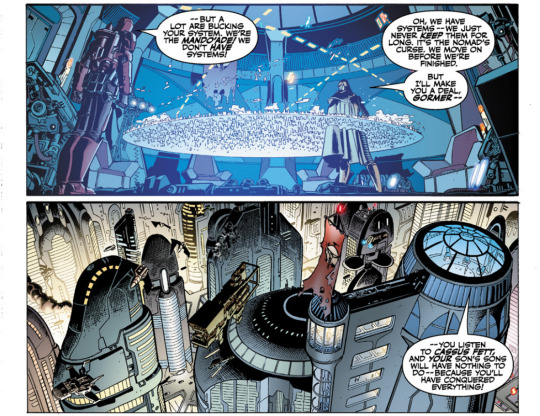
"--you listen to Cassus Fett and your son's sons will have nothing to do -- because you'll have concquered everything!"
Cassus admitted Mandalorians didn’t make full use of the resources of the conquered lands because they rarely stayed in one place for long (the curse of nomad life, as he called it) however he did not promise wealth to his subordinate but that Mandalorians are gonna conquer the whole galaxy leaving nothing for new generations.
Canderous Ordo mentioned in some of his game dialogues the fortunes (wealth):
Canderous: You want to hear tales of my exploits? Of the wars I've seen and fought, the enemies I've seen die by my hand? Heh, sure, I'll humor you. My name's Canderous of the Mandalorian clan Ordo. I've been fighting across the galaxy for 40 of your years. For my people it's the honor and glory of battle that rules us. It's through combat that we prove our worth, gain renown and make our fortunes. [KotOR game]
or
Mandalore: The Republic thinks my people are dead, scattered. They are wrong. You should have destroyed us when you had the chance. As long as one Mandalorian lives, we will survive. Our honor, fortunes, and lives revolve around battle. From our earliest history, this has been our way, as it will be, always. [KotOR 2 game]
however other tales made it clear money itself did not have the same value as armor, weapon and basilisk droids, as losing those three (cultural) things hurted defeated Mandalorians the most:
Canderous: The war we had with the Republic was supposed to be the most glorious battle of our history, but… it was a very costly one. I guess we didn't think of how much we could lose in it. [...] There weren't many of us left after that last battle. Mandalore himself was killed at the hands of the Jedi Revan. The best of us could not defeat him! After that last battle, those of us that survived were stripped of our weapons, our armor, and our Basilisks. Revan's forces destroyed them while we were forced to watch. Those who hadn't fled earlier were left with nothing to call their own: no weapons, no armor… only the honor of having fought in the battle we just lost. For many this was not enough. While the rest of us were sent into exile on the Outer Rim, they tried to relive the old days – raiding worlds. They're nothing more than bandits now. [KotOR game]
Canderous specifically said “Those who hadn't fled earlier were left with nothing to call their own: no weapons, no armor” so clearly, the “warrior equipment” is the wealth that Mandalorians cared for, not credits or other material luxuries. Similarly approach was seen a decade later in Mandalorian Camp on Dxun:
That idiot Kumus will be working off his shame for the rest of his days. Equipment eaten by cannoks - it would have been better if he'd let the jungle take him. [KotOR II]
However, as Canderous mentioned, after the Mandalorian Wars, this mindset changed in favor of money. Some Mandalorians turned into mercenaries, some kept raiding worlds, some turned into bandits attacking simple farmers. This sentiment was repeat by Veela from The Old Republic: Revan:
“When Revan hid Mandalore`s Mask, most of our people scattered in disgrace. But some of us refused to give up. We stayed behind to look for what was lost instead of running off to become mercenaries and hired thugs.”
Similar statements comes from History of the Mandalorians:
“Following their failed campaign, the Crusaders found a new object of worship -- the almighty credits. Decimated and embittered, the surviving Mandalorian warriors turned ruthlessly mercenary in order to survive. Informally called the Mandalorian Merc, these individuals hired out their lethal talents to the highest bidders without regard to silly notions like justice, morals, and honor.”
So, did members of Ha’rangir Clan enriched themselves during the Mandalorian Wars, as Shae Vizla said, or did they get their fortune from post-war raids, as Codex Entry suggests? This is an important question in context: how old the clan truly is? Because there is a chance that the clan's origin grew into myth over the time, the same as their “cultural” role.
I mean, Canderous and Veela of clan Ordo were eyewitnesses of change happening in their society while Shae Vizla and contemporary Mandalorians may only rely on knowledge passed down to them by their predecessors. Considering how Mandalorian people were broken and divided after war, it is quite possible that a lot of historical knowledge was lost or misrepresented, even on purpose.
At the same time, there were attempts to bring back Mandalorians to their honorable ways. The best known example is Canderous Ordo, who for his efforts earned the title Mandalore the Preserver. In KotOR II: Sith Lords, he said “Many Mandalorians have fallen from the path of honor and are now no more than common mercenaries. But that is changing” yet despite Ordo’s best intentions, the unity of Mandalorian clans is much more fragile than what it was under Taung leadership. But if Canderous could dedicate his life to rebuilding Mandalorian society under his banner (against Sith as Revan wanted), then logically thinking there could be more reformators like him. Which is another possibility to see Kad Ha’rangir. Not as a literal deity but actual historical figure who could renamed himself in honor of the warrior god[15], either presenting himself as “chosen” warrior / tool or maybe even as the god’s prophet of some sort or whose fame (interpretation of warrior culture) overtime grew into a myth that benefited the entire clan. TOR game presented us with Mandalorians such as Kur Ha’rangir and Arla Ha’rangir so Kad Ha’rangir easily could be a full name of real person who started the Ha’rangir family in the first place and whose person at some point merged into one with the mythical god in mandalorian collective consciousness. This brings back the question - did Taung truly knew Kad Ha’rangir under this exact name and not just, for example, simply as Ha’rangir?
As I hopefully established in previous parts, swords weren’t the traditional Mandalorian (Taung) weapon while the Kad Ha’rangir name, for the first time showed in in-universe source coexisting with the events taking place approximately 300 years after Taung died out. This is of course matter of game mechanics, but The Old Republic presents on screen
Mandalorian characters using commonly swords

lore entries like Mandalorian Relics: The Final Blade of Dunesa Rul (x)

[...] Rul's creations, prized within the Mandalorians, were often handed down from one clan leader to the next, but demand for new work was overwhelming. Rul was killed in an explosion during an altercation between Clan Mettir and Clan Ironstone, who sought to lay claim to a masterwork weapon--a durasteel dagger--he had created. Both clans were hunted down and destroyed in retaliation for the grievous loss. The dagger itself was never found.
Even the official duel between Mandalore the Avenger and Field Marshal Kol Heta was done with ceremonial swords
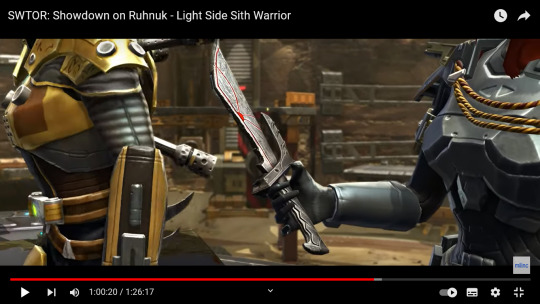
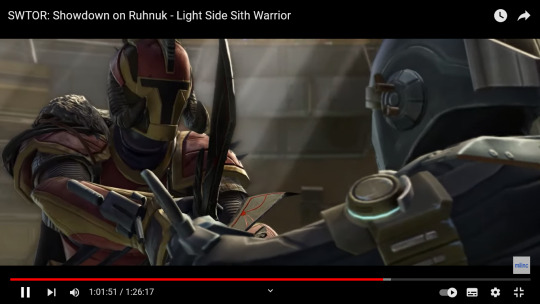
while so far the only axes I noticed are Gamorrean made (x)
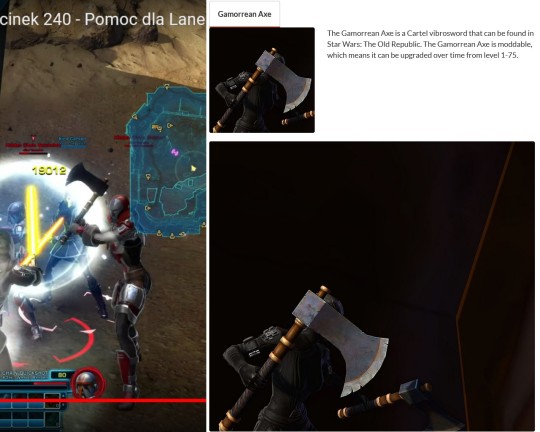
and vibro axe (x)

and none of those are even close in shape to traditional Mandalorian (Taung) ones. This kind of weapon seems to have lost its importance in the favor of swords/sabers, so if Kad Ha’rangir was a historical figure who either claimed or was hailed by others as descendant of an old god, he could be also a reason (impulse) for the switch from axes to swords. As in, Mandalorians considered him to have divine connections - or even be the embodiment of divine will - and started preferring swords as a symbol of their renewed faith to honor god. The mentioned in Codex Entry “a bloody expansion called "Ha'rangir's Path" in the latter half of 3732 BBY” fits well in that assumption and even could be treated as the approximate date of “religious (weapon) reformation”.
Like it was already mentioned, the unity between Mandalorian (human dominated) clans is a much more fragile matter than what we know about the Mandalorian society under leadership of the last two Taung rulers - the Indomitable and Ultimate. The conflict between old fashioned warriors and mercenaries started after Mandalorian Wars and will last to modern days however in The Old Republic game it took a surprising shape. The current conflict has divided Mandalorians into supporters of Mandalore the Avenger (Shae Vizsla, a former bounty hunter herself) and Field Marshal Kol Heta (leader of Hidden Chain) who wants to bring Mandalorians to their warrior roots and regain the lost independence. The surprising part of this conflict is that both sides acknowledged the need to preserve material artifacts to keep their culture intact and give people tangible connection to their history and past deeds.
And so TOR game included:
The Importance of Mandalorian Relics codex Lore Entry: For many Mandalorians, relics are an important touchstone to connect with their long and fractured history. The cultural identity of this clan-based group is centered around conflict and combat, so a chaotic history of war is expected. While grounded in a common creed and code, those who wish to understand and honor past achievements will look to items that gained significance during a specific event, battle, or because they were wielded by a person of great renown. These relics can become symbols of the core tenants of the Mandalorian beliefs; a physical embodiment of a philosophy that is rooted in the most primitive of contests between creatures of flesh and blood. Perhaps more than the leaders before her, Mandalore the Avenger recognized the importance of these relics in helping to unify the clans with a history they could see and touch, and so began to collect and house important artifacts from the past in order to smooth the path to the future.
or
Seeker's Vigil codex: Lore Entry: This heavily-guarded space-faring vault serves as a monument to what the Ash'ad consider the glories of Mandalorian culture. Within these fortified walls lay the history of conquest, raiding, victory, loss, and struggle that characterize a true Mandalorian warrior's existence. There are so many tomes in the libraries that the archivists have lost count. Tableaus and frescoes line the hallways, depicting Mandalorian battles whose names may be forgotten, but are still part of their history. It would take multiple lifetimes to even begin to uncover all of the knowledge hoarded within, and those that call this vessel home will ensure that if the Mandalorian way ever falters, they will be there to teach new generations what it really means to hunt and live the life of a raider.
or
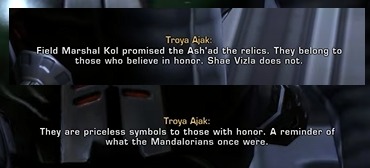
Troya Ajak: "Field Marshal Kol promised the Ash'ad the relics. They belong to those who believe in honor. Shae Vizla does not." "They are priceless symbols to those with honor. A reminder of what the Mandalorians once were."
The importance of relics collected by Shae Vizla’s supporters and Kol Heta’s Hidden Chain could also lead to a renewal of religion - however how true to original faith it was, is of course up to debate.
During Spirit of Vengeance Arc, the player was forced to walk through enemy ships belonging to Mandalorian clans such as Varad and Ash’ad. Here, clearly the various items

are treated differently than what we could see in frames presenting Shea Vizsla’s or Kol Heta’s meeting room.


The skulls and fire flames reminds me mentioned in previous part (#4) details from Cassus Fett and Demagol’s workplaces and may be a continuation of the same magical-religious traditions. What stands out the most is presents of altars and/or place of sacrifice.
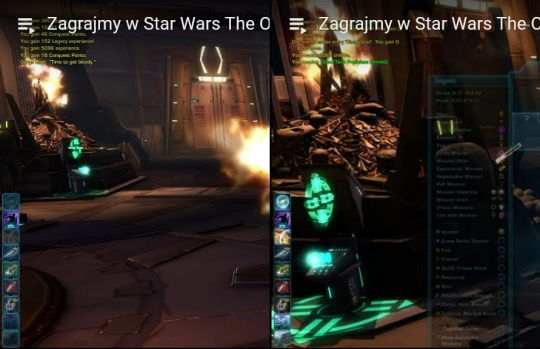
On one of the ships, there was even a great statue that resembles Mandalore the Ultimate
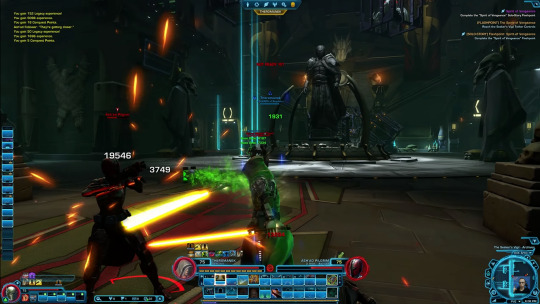
but could actually represent a god (Destructor maybe?), considering all the bones - sacrifices? - piled up around.
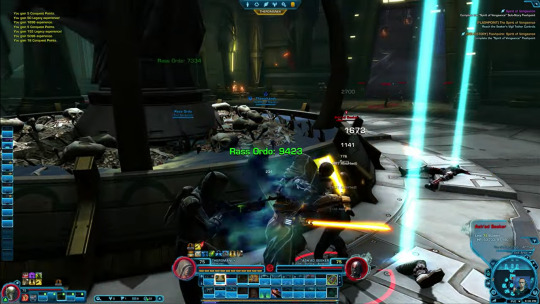
This is one of the better documented examples of likely religious practice among warriors.
In general, The Old Republic game is so far the one major source providing the most direct information about Kad Ha’rangir in relation to the events taking place, while “Death Watch Manifesto” [Bounty Hunter Code] and “Industry. Honor. Savagery: Shaping the Mandalorian Soul” [The Essential Guide to Warfare] were written in distant modern times. At the same time, the game did not include the traditional Mandalorian (Taung) mythosaur axe, as in this era the swords are the most common weapon alongside blasters. Which leads me to believe that Kad Ha’rangir may be a side effect of religious renewal that happened decades after the original Mandalorians died out, as religion in itself is a very good carrier of culture and binder for a broken community. As post-KotOR sources provided, Mandalorian people were divided and in need of symbol(s) under which they could unite - a need recognized by both Shae Vizsla and Kol Heta. Thus the founder of the Ha'rangir clan could become one of such symbols and his achievements and/or charisma at some point grew into a myth affecting Mandalorian people’s perception of original (Taung) gods. As humans dominated warrior society, it makes sense that some aspects of older culture took different shapes to fulfill their needs.
My final conclusion (theory) is that the “Destructor” was part of Taung mythology albeit there was no connection between warrior god and sword/sabers - if anything, the deity’s attribute was an axe which is why the weapon was held in such great regard. However once Taung died out leaving remnants of Mandalorians scattered and broken, some warriors took upon themselves to resurrect their culture. Ordo Canderous tried to unite Mandalorians under his banner (against Sith), while some time later, Kad Ha’rangir, as a historical figure, brought changes - religious reformation? - that influenced perception of old mythology and somehow, maybe in honor of his name, swords for good replaced mythosaur axes. Later, Tarre Vizsla - the first Mandalorian Jedi - created darksaber that became another important relic that affected his people’s spiritual and material culture.
The modern authors based their knowledge in majority on sources that were passed down to their era and could over time become distorted or their original meaning has completely lost. Which could explain the discrepancies between what sources showed and the knowledge of the (in-universe) authors.
SIDENOTES:
[12] Lane said this story about her brother's death:

Years ago, Kur Ha'rangir challenged my brother to a duel. Over some perceived slight against his famous name. Kur used nothing but underhanded tricks-like he does with everything else, There was no honor in the way he fought... He killed by brother... and no one called out Kur's deception. Typical, for a Ha'rangir.
[13] Another example implying Taungs & Neo-Crusaders had a special respect for (dead) ancestors/family members is the specific greeting used by Mandalore the Ultimate during meeting with Arkanian leader

... and all honor to your family's dead [KotOR #20]
And Ko Sornell while adressing Cassus Fett (one of the closest advisors of Mandalore):
Su'cuy, Cassus Fett, and all honor to your family's dead. [KotOR: Interference short story]
[14] The honor duel does not exactly need to end with the loser's death, as Ulic spared Mandalore the Indomitable’s life but as sources show, death was an usual occurrence. Frankly, the example of Canderous Ordo vs Jagi implies that once the challenge was issued there was no way to revoke it. Even though Jagi learned that his former commander’s action were not motivated by selfishness (glory-seeking) as he assumed for years and accepted his accusation turned out to be false and unfair, the man committed suicide to clean his own name:
Canderous: I saw a chance and had to take it. It ended the battle quicker than we would have otherwise, and many of our warriors may have died. Mandalore taught us that opportunism and flexibility in battle were to be admired. You may contradict me, but do you contradict him as well? Jagi: No! I... I... I see that I have been wrong. I have not been true to the teachings of Mandalore. You were right. I was wrong to question your honor. But I must now cleanse mine with my life.

Jagi didn't haveto fight Canderous, and you tried to persuade him not to. The Mandalorian sense of honor, however, would not let him live having done what he has. Jagi took his own life in the Dune Sea. This has deeply affected Candeour. [KotOR game]
[15] Similar like clone trooper KADDAK used the name of Mandalorian god in Darth Vader: Cry of the Shadow
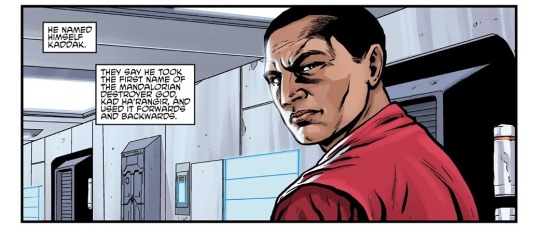
He named himself Kaddak. They say he took the first name of the Mandalorian Destroyer God, Kad Ha'rangir, and used it forwards and backwards.
#star wars#mandalorians#mandalorian culture#Cienie’s take on Mandalorian Culture#kad ha'rangir#taungs#to my regret i couldn't use all screenshots and frames I had collected due to picture limits lol#i finally finished it#i strongly believe that taungs knew the god of destruction but rather under simple name of ha'rangir#while the “kad” part was added over time#and started the era of sword / saber and its special role in mandalorian culture & religion#mandalorian culture is pretty dynamic one when it comes to changes and evolutions or rather revolutions
16 notes
·
View notes
Text
Witches FAQ
(I started to post some of this on Kate AA's entry about her headcannons, but I figured I would post more information here as I thought more about everything!)
How does one catch/identify a witch?
It's not easy!!! A witch is defined as someone who can see creatures from the other realm (whether you call these creatures demons or guardians is up to your religion). Those who believe them to be demons are often driven mad by The Sight and everyone around them knows they are suffering. Generally, these people are less likely to be identified as ~witches~ are more likely to be identified as "possessed". While some extremists would believe that they deserve to be put to death just as any other witch, more lenient leaders will simply imprison them (for their own safety). But ultimately, those who are "possessed" tend to be driven to the point of taking their own lives.
On the other hand, those who have The Sight and are not driven to madness by seeing the demons and, instead of trying to avoid them, actively provide them with gifts/encourage them, are definitely witches and 100% need to be put to death. The biggest problem here, is that it is generally easy for a witch to conceal that they are a witch, if they wish it. On rare occasions, witches have performed magic (the details of which I will outline later), but ultimately their abilities is something that cannot be proved.
Most witch trials have come down to witness testimonies where there have been multiple sworn accounts of people saying that they have personally been told by the accused that they are a witch or that they've seen them perform magic. Sometimes even that they've seen them bestow gifts or speaking to "something that was not there". All of these accounts generally cannot be proved beyond the word of the witness, so being accused of being a witch (especially in places where they honor the single god) is a very easy thing to have happen to you, if enough people will testify against you! (Which makes the fact that Roderick didn't have any sort of trials with the Pyke Walk even more unhinged and I love it)
What sort of magic can witches preform?
Generally witches do not have any abilities beyond The Sight.
However, guardians can bestow some low level magic to witches if they choose. This typically manifests in basic healing abilities (the ability to instantly cure any ailment/injury that is not fatal) and premonitions (that don't always come true but is just one possible future). They also can help strengthen the invisible protections between this world and the next.
Guardians are proud beings and they don't generally like to share their powers. Even if though they often have some affection for the humans who can see them, they do ultimately see them as lesser than and do like the superiority their own magic abilities give them. But in times of Great Peril, they are often persuaded to do so. (This could be as simple as the home in which they protect is in danger, or the gods, themselves have returned. @phabblebabbles -- Aria could definitely already have these abilities considering her current situation, but I'll leave that up to you!)
But keeping these abilities secret is also an easy thing to do. The guardians know it is in their own best interest to help train the witches to do these things, but also in such a way that they will not be detected -- especially if they are surrounded by enemies, which they often are if they've been given magic. The risk with this is, of course, is that they could potentially be seen, especially if they are caught healing someone.
There has been an account of the gods bestowing similar powers as their own onto witches -- which is what ultimately spurred the myth that should the gods return, one might be able to harness their powers for their own. (I'll have more details on this, later, but there are no official accounts of this in either Astairan myths or history, as the event was supposed to be buried and forgotten).
6 notes
·
View notes
Note
"Fun fact: Walt Disney first had the idea to open his own theme park after visiting Griffith Park in Los Angeles. Disneyland – which was originally called Mickey Mouse Park, at least during the planning stages – and officially opened to the public on July 17 , 1955 in Anaheim, California. Back then, a ticket cost $2.50!"
Hi Dani! I read your last fic and when I read the final footnote it made me laugh and I wanted to tell you an interesting fact about Argentina. I live in La Plata, a city neighboring Buenos Aires, much smaller and one of the most planned and organized cities in terms of its distribution. My city has a public theme park (which means it's free) called El País de los Niños (The Land of Children) (also called La Ciudad de Los Niños -The City of Children) and it has attractions like roller coasters, cultural centers, museums, small judicial systems with chambers of deputies in miniature so that children learn about the Argentine judicial system (there are also simpler games such as carousels or swings). But what I was going to tell you, based on your interesting fact at the bottom of the note, is that in Argentina since the 1950s there has been a rumor that this park was Walt Disney's inspiration to create Disneyland.
Although it could never be proven, the myth took hold. Some even risk that Disney participated in the inauguration that took place on November 26, 1951, when the work that had begun two years earlier and in which 1,600 workers participated was completed. They also say that Walt then met with President Juan Domingo Perón and proposed turning that small city, whose central idea was to teach children how the institutions of the Republic work, into an amusement park. Perón would have said no. Four years later, in Anaheim, California, the first Disneyland opened.
The historian Claudio Panella, a teacher and researcher specialized in Peronism at the National University of La Plata, assures that there is no concrete evidence that allows us to affirm that Walt Disney was inspired by the Republic to build his empire. “What can be pointed out, however, is that a myth has been created in this regard and, as such, it has firmly established itself in the popular imagination and continues to be transmitted from generation to generation,” he says.
And I thought your information was very funny because in the Latin fandom (among the Argentinians) we always played with the idea that Magnus went to see the inauguration of one of the first theme parks in the world with Ragnor, Catarina and Tessa and that years later he would take - along with Alec - his children to El País de los Niños and we always talked about how Rafe would absolutely love this park! Im even going to make a fic about this!
Annie storming into my askbox with fun facts and history lessons - you know the way to my heart huh??
I LOVED THIS. SO MUCH. THANK YOU.
First of all, I love the theme park. I love the name and I love that it's free and I looooooove that it gives space for children to learn about law and governance (how fucking cool is that??). I feel like Rafael would love this!!! (gonna make a note of this btw)
And ngl it is 100% possible that Disney took "inspiration" from this. White people love taking other people's cultures (and ideas!) and making their own 🤡
I definitely think Magnus would've been there. He loves traveling and he loves adventure!
You should totally write a fic about this!! Please do share it if you're okay with it 💙
12 notes
·
View notes
Text
Nǚ Jì Sī and Guì Zi Shǒu
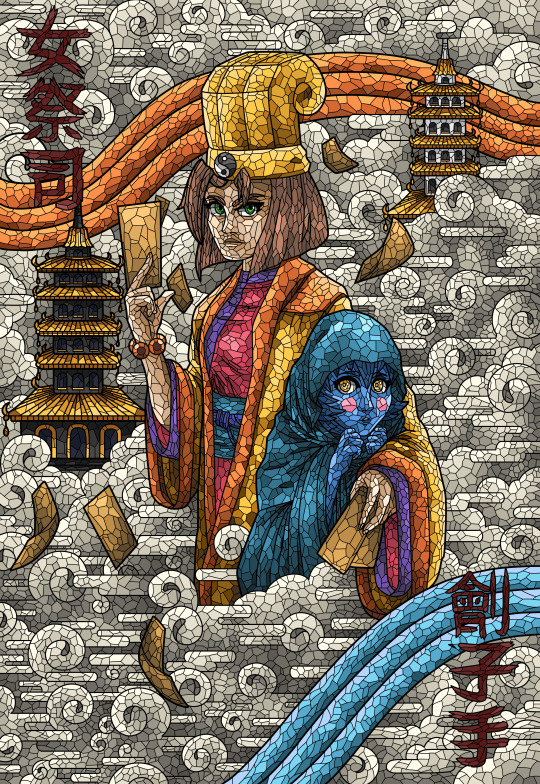
(Credit: @masterartlocked) You may be curious what is with this art and the names? 'Those are Mei-Ling and Hsien-Ko you silly' you might be saying to me. Well, in the lore of Cryas Darkstalkers, there is an interesting turn of events due to following their journey from the beginning. When they first went about their journey, they figured that due to Hsien-Ko's appearance being overtly less human than Mei-Ling, she would need to hide her appearance from the eyes of humans. To do this, Mei-Ling made a cloak for her sister to wear in order to conceal herself in the times they walk through a village. Initially, Hsien-Ko only ventured with Mei-Ling at night to ensure she would not be recognized as being non-human. While a few close calls, they got pretty good at it. This was necessary since they did need to accept jobs of hunting and exterminating the Darkstalkers in order to get information regarding any stories about places of interest in the many vast areas of China.
Slowly over the decades however, an unintended side effect of their exploits would occur. As Mei-Ling was the one being seen and they would retread through places they have been to on many occasions over the decades, people would start noticing this ageless, beautiful mystic. Not only that, but people also realized how she and her hooded companion were effective in their job of ridding their lands of the creatures of the night. With this air of mystery, stories would begin to spread across the roads of this woman being possibly a spirit. More than that.... she could be a Xian. The stories would begin to tell of a Xian whose beauty was said to be unmatched with her elegant face, hair of many lustrous shades of umber, and eyes more brilliant than the finest jade. She was said to have descended from the heavens to finally free the people and Zhōngguó (中國) from the grasps of the demons and monsters that brought suffering and death to their livelihoods. While many names were thrown of this Xian, eventually the name of 女祭司 (Nǚ Jì Sī) would stick. This name of 'priestess' was fitting due to her appearance. Once the sisters started catching on due to hearsay they heard, artwork that began popping up, and even being greeted as such, they had their own reactions to Mei-Ling’s title. While Mei-Ling was incredibly embarrassed and flustered at this effective deification of her (especially with all the myths speaking of her otherworldly beauty), Hsien-Ko found it incredible. She loved the idea that her sister was effectively becoming part of the mythos of different cultures throughout the lands, just like the many mythical beings they learned about in their youth.
The stories didn't stop with Mei-Ling. While her sister was more prominent in these new legends that were unfolding, Hsien-Ko herself would gain titles. The most popular that stuck was 劊子手 (Guì Zi Shǒu), which means ‘executioner’. Due to the fact Mei-Ling did most of the talking, not many people knew what this cloaked individual’s relation to Nǚ Jì Sī was. Some thought they might be a follower, keeping record of the Xian’s many deeds as she traveled the lands ridding the Darkstalker threat. However, due to many stories noticing them dragging a large coffin with them, they believed this individual may actually be quite strong. Some believe they act like an attack dog on a leash, sicked on to the Darkstalkers by Nǚ Jì Sī. The gender of this being has been put into question as not many have heard their voice. However, those who have said it sounded like a woman, full of cheeriness in her tone in one moment and sounding very serious in others. Some wonder if this being is even human. Some believe she may be one that was bestowed great power by Nǚ Jì Sī. Others think she may in fact be a spirit or Xian herself. The more outrageous claims think she may in fact be a demon under the control of Nǚ Jì Sī, repenting for their past transgressions by serving the guardian deity.
When the two learned of this via gossip and art that depicted her (in various ways based on each person’s belief), Hsien-Ko and Mei-Ling had their thoughts. Hsien-Ko thought it was genuinely cool that despite not having her face being shown, she was still effectively becoming a mythical figure, like the being that she obtained her name from. She had a fondness for the title Guì Zi Shǒu. Mei-Ling on the other hand felt some sense of resentment. Considering the spotlight she was receiving despite the fact Hsien-Ko is the one putting in the hard work of defeating the Darkstalkers they faced in their hunts, she felt it was unfair, especially when some artwork depicted her sister as this demon under her control. Part of her wishes she could do something to silence this depiction of her young sister, but Hsien-Ko would calm her sister’s furrowed brow. She explains that if anything, these myths help make their travels easier since humans are more willing to provide aid to a Xian rather than some traveling hunters. And to her, she thinks it is cool that people get creative with these really cool ideas about who she is. She likes the idea of being this powerful enigma to the masses.
#cryas darkstalkers#darkstalkers#auranova26#hsien ko#mei ling#lore#shao#chinese#jiangshi#xian#nujisi#guizishou#china#zhongguo#hsien-ko#mei-ling#hooded#beautiful#big sister is being seen as a deity#stained glass
11 notes
·
View notes